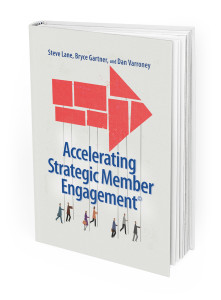 3 Core Strategies to Win New Members. Long gone are the days when corporations join Associations on the basis of “good citizenship.” The severe downturn resulted in high volume dues reductions and membership cancellations across the board. While some signs in the economy are promising, the recovery is not as robust as many had hoped. New member acquisition is still a steep hill to climb and it requires new thinking. Building a strategy from the Prospect’s Business Perspective helps Associations sharpen their market focus and grow membership.
3 Core Strategies to Win New Members. Long gone are the days when corporations join Associations on the basis of “good citizenship.” The severe downturn resulted in high volume dues reductions and membership cancellations across the board. While some signs in the economy are promising, the recovery is not as robust as many had hoped. New member acquisition is still a steep hill to climb and it requires new thinking. Building a strategy from the Prospect’s Business Perspective helps Associations sharpen their market focus and grow membership.
Life Inside Prospect Companies
Corporations manage their businesses for maximum cash flow, and spending decisions must reflect positively on quarterly and annual earnings. Also, having sufficient liquidity to invest in acquisitions and having ample cash resources to withstand another downturn is a common theme. How do Associations and membership organizations come to grips with this reality? By developing campaign strategies from a prospective member’s vantage point.
Times Have Changed
The view inside the C Suite at prospect companies is decidedly different than the 1980’s. Today, fewer executives are tasked with performing more functions and in many situations the majority of sales and earnings growth comes from outside the United States. The task load is substantial. More meetings and increased travel makes it nearly impossible to get and keep an executive’s attention for more than a few minutes.
Senior corporate executives must deliver results, and they are not interested in membership pitches. They need solutions that help them and their companies achieve business objectives.
3 Core Strategies to Win New Members
1. View the marketplace as Prospect Executives do
Prospect companies, similar to members, are tuned to their own channel “WIIFM” What’s In It For Me. They join Associations where they perceive their participation moves the needle and help them achieve their business objectives. Research prior to meetings is essential. Utilize a legislative and regulatory impact statement to confirm and quantify critical needs. Determine how pending regulations or legislation impedes the company’s ability to meet profit targets in the next five years. (http://bit.ly/1btcvac).
2. Provide regulatory, legislative or training solutions that help prospects achieve results
Cite specific examples of how membership contributes to their bottom line. Utilizing the “pain point” issues, show how participation helps the company achieve their business objectives. Point to tangible examples of how other companies (customers and competitors) leverage their membership to achieve their business objectives. Have contact information available if prospects want to contact other executives for references. Nothing sells new members better than satisfied members!
3. Have an engagement culture assuring impact on policy and the Association’s overall direction.
Not every company can have a senior executive serving on an Association’s board. As a result, they expect an Association culture that welcomes, considers and accepts new input. With time and financial resources short prospects expect a community focus where everyone works collaboratively to achieve the same objectives.
3 Core Strategies to Win New Members
Looking at recruitment from a Prospect’s Business Perspective helps Associations and membership organizations open more doors and secure new members. Some CEOs are seeing appreciable success. An Association is enjoying their third year of above plan new member growth and a different CEO reports consistent double digit new member growth.
One Association Executive noted “the cookie cutter and boiler plate approach no longer works. Prospects want allies to help them achieve success in the marketplace.” Absolutely correct, anything less than that will close more prospect’s doors than it will open.
For a free copy of the “Accelerating Strategic Member Engagement” eBook, request your copy at www.potomaccore.com.





